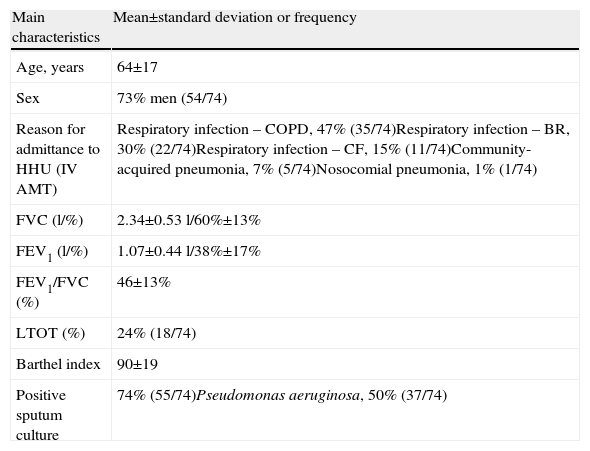Home intravenous antimicrobial therapy (AMT) administered in a Home Hospitalization Unit setting can be an alternative to conventional hospitalization in patients with exacerbation of a chronic respiratory disease as a consequence of a respiratory infection. Our objective was to analyze its effectiveness and safety in chronic patients who were remitted directly from the Respiratory Disease Day Hospital.1,2
The Home Hospitalization Unit of the Hospital de Sabadell keeps a prospective registry of patients treated. Based on these data, an observational study was carried out describing the cases referred for home intravenous AMT from the Respiratory Disease Day Hospital between January 2008 and December 2011. Admittance to the program was decided upon by both medical teams and accepted by the patient and/or primary caretaker. The infusion devices used were portable and disposable continuous-infusion elastomeric pumps (Intermate SV 200, Intermate XLV 250, Intermate LV 250, Baxter). The first dose of the treatment was administered at the Respiratory Disease Day Hospital. Later doses were administered in patients’ homes by either the patients themselves and/or their primary caretakers after a training process provided by the Home Hospitalization Unit nursing staff. Home therapy was supervised by the nursing staff over the phone and with home visits (usually every 48h). The descriptive statistical analysis was done with the SPSS version 18 statistical program, calculating means and standard deviations in the case of quantitative variables and percentages in the case of the qualitative variables. During the period described, 50 patients were included, generating a total of 74 home IV AMT cases. The main characteristics of the cases treated are summarized in Table 1.
Main Patient Characteristics (n=74).
| Main characteristics | Mean±standard deviation or frequency |
| Age, years | 64±17 |
| Sex | 73% men (54/74) |
| Reason for admittance to HHU (IV AMT) | Respiratory infection – COPD, 47% (35/74)Respiratory infection – BR, 30% (22/74)Respiratory infection – CF, 15% (11/74)Community-acquired pneumonia, 7% (5/74)Nosocomial pneumonia, 1% (1/74) |
| FVC (l/%) | 2.34±0.53 l/60%±13% |
| FEV1 (l/%) | 1.07±0.44 l/38%±17% |
| FEV1/FVC (%) | 46±13% |
| LTOT (%) | 24% (18/74) |
| Barthel index | 90±19 |
| Positive sputum culture | 74% (55/74)Pseudomonas aeruginosa, 50% (37/74) |
BR: bronchiectasis; COPD: chronic obstructive pulmonary disease; FEV1: forced expiratory volume in 1s; CF: cystic fibrosis; FVC: forced vital capacity; LTOT: long-term oxygen therapy; IV AMT: home intravenous antimicrobial therapy; HHU: Home Hospitalization Unit.
Home intravenous AMT was administered by the primary caretaker in 63% of the cases and by the patients themselves in 37%. The most frequently-used venous accesses were abbocath-type peripheral catheters (47%) and peripherally-inserted central venous catheters (47%); in the remaining 6%, previously-implanted port-a-caths were used. There were 30% fewer complications derived from the venous access methods, the majority of which (92%) were resolved in patients’ homes. Mean hospital stay was 19 days (SD 13), eliminating a total of 1416 potential days of hospitalization.
In 87% of the cases clinical evolution was satisfactory, but 13% required conventional hospitalization due to poor clinical evolution. After discharge, 12% of the cases required re-admittance during the following month and 16% during the following 3 months. The percentage of failure (need for conventional hospitalization) observed during home IV AMT in our study was similar to that reported in other published papers. However, it is necessary to keep in mind that these experiences are very heterogeneous and depend on the population in which home IV AMT was used, the type of infection treated and the germ involved: 3.6% in a group of 81 patients (111 episodes) with respiratory infection due to Pseudomonas aeruginosa3; 7.5% in a series of 42 patients (145 episodes) with different infections that required home IV AMT4 and up to 20.7% in another group of 82 patients with infections caused by multi-resistant microorganisms, among which the most frequent was respiratory tract infection.5 The percentage of readmittances within 3 months of follow-up also coincided with that of other series.4 Our results confirm that self-administered home IV AMT, controlled in a Home Hospitalization Unit program, is a safe and effective system for the management of respiratory infection in patients with chronic respiratory disease. The patients are able to be sent directly for treatment from the Respiratory Disease Day Hospital to the Home Hospitalization Unit, eliminating the need for visits to emergency departments as well as conventional hospitalizations.
Please cite this article as: Montón C, et al. Tratamiento antibiótico domiciliario endovenoso en la enfermedad respiratoria crónica. Arch Bronconeumol. 2013;49:174–5.










